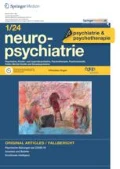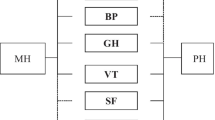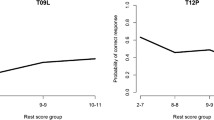Summary
Background
The present study compares the 30-, 20-, and 12-items versions of the General Health Questionnaire (GHQ) in the original coding and four different recoding schemes (Bimodal, Chronic, Modified Likert and a newly proposed Modified Chronic) with respect to their psychometric qualities.
Methods
The dichotomized versions (i.e. Bimodal, Chronic and Modified Chronic) were evaluated with the Rasch-Model and the polytomous original version and the Modified Likert version were evaluated with the Partial Credit Model.
Results
In general, the versions under consideration showed agreement with the model assumption. However, the recoded versions exhibited some deficits with respect to the Outfit index.
Conclusions
Because of the item deficits and for theoretical reasons we argue in favor of using the any of the three length versions with the original four-categorical coding scheme. Nevertheless, any of the versions appears apt for clinical use from a psychometric perspective.
Zusammenfassung
Hintergrund
Die vorliegende Studie hatte zum Ziel, die 30-, 20- und 12-Item-Versionen des General Health Questionnaire (GHQ) und vier verschiedene Rekodierungen (Bimodal, Chronic, Modified Likert und eine erstmals vorgeschlagene Modified Chronic) bezüglich psychometrischer Ansprüche zu vergleichen.
Methodik
Die dichtomisierten Versionen (Bimodal, Chronic and Modified Chronic) wurden mittels Rasch- Modell und die polytome Originalversion sowie die Modified Likert Version mittels Partial Credit Modell untersucht.
Ergebnisse
Insgesamt zeigten die untersuchten Versionen weitgehende Übereinstimmungen mit den Modellannahmen. Nichtsdestotrotz wiesen die rekodierten Versionen Defizite bezüglich des Outfit Index auf.
Schlussfolgerungen
Aufgrund der Item-Defizite und aus theoretischen Überlegungen argumentieren wir für die Verwendung der originalen 4-kategoriellen Kodierung für alle drei Versionen des GHQ, jedoch ist jede der Versionen aus psychometrischer Sicht für den klinischen Gebrauch geeignet.





Similar content being viewed by others
References
Goldberg DP. The detection of psychiatric illness by questionnaire. NY: Oxford University Press; 1972.
Goldberg DP, Cooper B, Eastwood MR, Kedward HB, Shepher M. A standardized psychiatric interview for use in community surveys. Br J Prevent Soc Med. 1970;24:18–23.
Jacob K, Brugha D, Mann A. The validation of the 12-item General Health Questionnaire among ethnic Indian women living in the United Kingdom. Psychol Med. 1997;27:1215–7.
Schmitz N, Kruse J, Heckrath C, Alberti L, Tress W. Diagnosing mental disorders in primary care: the Genreal Health Questionnaire (GHQ) and the Symptom Checklist (SCL-90-R) as screening instruments. Soc Psychiatry Psychiatr Epidemiol. 1999;34:360–6.
Malt UF. The validity of the General Health Questionnaire in a sample of accidentally injured adults. Acta Psychiatr Scand. 1989;80:103–12.
Goldberg PD, Williams P. A user’s guide to the General Health Questionnaire. Windsor: NFER-Nelson; 1988.
Andrich D, van Schoubroeck L. The General Health Questionnaire: a psychometric analysis using latent trait theory. Psychol Med. 1989;19:469–85.
Smith AB, Fallowfield LJ, Stark DP, Velikova G, Jenkins V. A, Rasch and confirmatory factor analysis of the General Health Questionnaire (GHQ)—12. Health Qual Life Outcomes. 2010;8:45.
Delgado-Gomez D, Lopez-Castroman J, de Leon-Martinez V, Baca-Garcia E, Cabanas-Arrate ML, Aguado D. Psychometrical assessment and item analysis of the general health questionnaire in victims of terrorism. Psychol Assess. 2013;25:279–87.
Samejima F. Estimation of latent ability using a response pattern of graded scores. Psychometrika Monogr Suppl 34. 1969.
Goodchild ME, Duncan-Jones P. Chronicity and the General Health Questionnaire. Br J Psychiatry. 1985;146:55–61.
Jansen PGW, Roskam EE. Latent trait models and dichotomization of graded responses. Psychometrika. 1986;51:69–91.
Roskam EE, Jansen PGW. Conditions for Rasch-dichotomizability of the unidimensional polytomous Rasch model. Psychometrika. 1989;54:317–32.
Andrich D. Models for measurement, precision, and the nondichotomization of graded responses. Psychometrika. 1995a;60:7–26.
Andrich D. Further remarks on nondichotomization of graded responses. Psychometrika. 1995b;60:37–46.
Friedrich F, Alexandrowicz R, Benda N, Cerny G, Wancata J. The criterion validity of different versions of the General Health Questionnaire among non-psychiaric inpatients. Soc Psychiatry Psychiatr Epidemiol. 2011;46:635–41.
Stevens SS. On the theory of scales of measurement. Science. 1946;103:677–80.
Rasch G. Probabilistic models for some intelligence and attainment tests. Copenhagen: Danmarks Pædagogiske Institut; 1960.
Rasch G. An individualistic approach to item analysis. In: Lazarsfeld PF, Henry NW, editors. Readings in mathematical social science. Cambridge, MA: The MIT Press; 1966. pp 89–107.
Masters GN. A Rasch model for partial credit scoring. Psychometrika. 1982;47:149–74.
Baker FB, Kim S-H. Item response theory: parameter estimation techniques. 2nd revision, revised and expanded. NY: Marcel Dekker; 2004.
Mislevy RJ. Randomization-based inference about latent variables from complex samples. Psychometrika. 1991;56:177–96.
Warm TA. Weighted likelihood estimation of ability in item response theory. Psychometrika. 1989;54:427–50.
Wu ML, Wilson MR. ConQuest: multi-aspect test software [Software Handbook]. Camberwell: Australian Council for Educational Research; 1997.
Christensen KB, Kreiner S, Mesbah M, editors. Rasch models in health. Hoboken: Wiley; 2013.
Engelhard G. Invariant measurement. Using Rasch models in the social, behavioral, and health sciences. NY: Routledge; 2013.
Fischer GH, Molenaar IW, Models R. Foundations, recent developments, and applications. NY: Springer; 1995.
Rocha NS, Chachamocvich E, Almeida Fleck MP, Tennant A. An introduction to Rasch analysis for psychiatric practice and research. J Psychiatric Res. 2013;47:141–8.
Glas CAW, Verhelst ND. Testing the Rasch model. In: Fischer GH, Molenaar IW, editors. Rasch models. Foundations, recent developments, and applications. NY: Springer; 1995. pp. 69–95.
Andersen EB. A goodness of fit test for the Rasch model. Psychometrika. 1973;38:123–40.
Glas CAW. Differential item functioning depending on general covariates. In: Boomsma A, van Duijn MAJ, Snijders TAB, editors. Essays on item response theory. NY: Springer; 2001. pp. 131–48.
Draxler C. Sample size determination for Rasch model tests. Psychometrika. 2010;75:708–24.
Draxler C, Alexandrowicz RW. (in press). Sample size determination within the scope of conditional maximum likelihood estimation with special focus on testing the Rasch model. Psychometrika.
Christensen KB, Bjørner JB, Kreiner S, Petersen JH. Testing unidimensionality in polytomous Rasch models. Psychometrika. 2002;67:563–74.
Smith AB, Rush R, Fallowfield LJ, Velikova G, Sharpe M. Rasch fit statistics and sample size considerations for polytomous data. BMC Med Res Method. 2008. doi:10.1186/1471-2288-8-33.
R Core Team editor. R. A language and environment for statistical computing. Vienna: R Foundation for Statistical Computing; 2014. http://www.R-project.org.
Alexandrowicz RW. R in 10 Schritten. Einführung in die statistische Programmierumgebung. Wien: Facultas/UTB; 2013.
Mair P, Hatzinger R, Maier MJ. eRm: Extended Rasch modeling. R package version 0.15–1. 2012. http://CRAN.R-project.org/package=eRm. Accessed 21 Sep. 2015.
Wiedermann WT, Alexandrowicz RW. A plea for the Wilcoxon-Mann-Whitney-Test: further considerations on Rasch & Guiard́s ‘The robustness of parametric statistical methods’. Psychology. Science. 2007;49:2–12.
Alexandrowicz RW, Fritzsche S, Keller F. Die Anwendbarkeit des BDI-II in klinischen und nichtklinischen Populationen aus psychometrischer Sicht. Eine vergleichende Analyse mit dem Rasch-Modell. Neuropsychiatrie. 2014;28:63–73.
Acknowledgements
The authors are indebted to Marco Maier for invaluable programming assistance in calculating the required person parameter estimates used in Fig. 4.
Helsinki-Declaration
The data for the clinical samples were collected in two health centers in accordance with the respective ethical guidelines in place.
Conflict of interest
Rainer W. Alexandrowicz, Fabian Friedrich, Rebecca Jahn, and Nathalie Soulier declare that they have no conflict of interest.
Author information
Authors and Affiliations
Corresponding author
Electronic supplementary material
Rights and permissions
About this article
Cite this article
Alexandrowicz, R.W., Friedrich, F., Jahn, R. et al. Using Rasch-models to compare the 30-, 20-, and 12-items version of the general health questionnaire taking four recoding schemes into account. Neuropsychiatr 29, 179–191 (2015). https://doi.org/10.1007/s40211-015-0160-z
Received:
Accepted:
Published:
Issue Date:
DOI: https://doi.org/10.1007/s40211-015-0160-z




